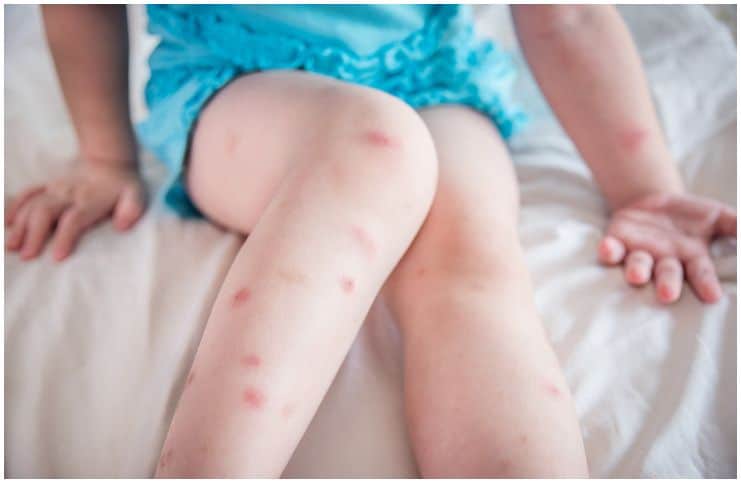Bed Bug Bites Facts
Bed bugs are small, flat, oval-shaped insects. They feed on blood as their only source of nutrition. They do not fly.
They are attracted by carbon dioxide and body warmth. Their color varies from red, dark yellow, or brown. The ones that usually plague humans are the tropical bedbug Cimex hemipterus and the common bedbug Cimex lectularius. They are most active when people are asleep, early in the morning, and during the night.
They inject an anticoagulant along with their saliva (which also numbs your skin so you can’t feel the bed bug biting you) when they pierce the skin of their victim to take a blood meal.
Symptoms
The first sign may be itchy bites on the skin, commonly on the shoulders or arms. They do not seem to spread any type of disease to people. If the area of the bite becomes swollen, a small red welt may appear.
Itching from these bites can be so bad that some individuals will scratch sufficiently to cause breaks in the skin which may get infected. For some unknown reasons, most people over 65 do not have an allergic reaction to this type of bites.
Treatment
Typically, no allopathic treatment is needed for this kind of bites. However, if itching is severe, you may use oral antihistamines or steroid creams as well as natural home remedies, such as aloe vera gel, lemon juice, apple cider vinegar, or baking soda.
Prevention
- when traveling, check hotel linens and mattresses as well as furniture and bed upon check-in;
- it is important to avoid picking up furniture from garage sales since it is one of the most common methods of bringing in these pests into your home;
- vacuuming the carpets weekly.
Tips
- leaving your home for a few weeks (even months) will not get rid of these unwanted pests because they can live for about a year without blood;
- they cannot bite through clothing, therefore, they are always going to look for exposed skin.
Mosquito Bites Facts
Only female mosquitos bite humans. While both of them feed on water and plant nectar, females also need blood in their diet to reproduce. Without blood, the eggs don’t mature to the point that the females can lay them for hatching.
After females have consumed enough blood, they will rest for 2-3 days before laying her eggs.
Female mosquitos can live up to one month, and the males live for about seven to 10 days. Also, some females can hibernate in the winter; thus, they can live for a few months.
When a mosquito inserts her proboscis (an elongated appendage from the head of a mosquito) through the skin, her saliva creates a red bump. These nasty bumps produce mild to severe itching in kids and people.
While mosquito bites are commonly harmless, occasionally they can cause serious illness, like Skeeter syndrome. At its worst, they can cause anaphylaxis, an acute, potentially fatal, multiorgan system reaction characterized by generalized hives, throat swelling, wheezing, or faintness. Children are more vulnerable to this type of allergic reaction.
Symptoms
A typical bite commonly presents with a reddish, raised welt on the skin.
Treatment
You can use a topical antihistamine product on the bites for immediate relief and also ingest a dose of an oral antihistamine to calm the irritation and itch.
Aloe vera gel can relieve the swelling and itch. Moreover, you may use vitamin E oil topically twice per day to reduce redness and for faster healing.
Prevention
- avoid the use of sweet-smelling perfumes and lotions since mosquitos are attracted to these scents;
- use insect repellent because it is one of the most efficient ways to prevent a bite. There are three active ingredients approved – icaridin (also known as picaridin), DEET (shorthand for the chemical name N, N-diethyl-meta-toluamide), and oil of lemon eucalyptus;
- eating garlic regularly also offers some protection from mosquitoes, both from the sulfur substances which you emit through your skin as well as the odor on your breath;
- covering up with clothing lowers the amount of skin which can be bitten – light-colored clothing, high necked, long shirts and sleeves, and trousers;
- these bugs only need about ½ inch of water to breed, hence, eliminating areas of standing water, such as – birdbaths, flowerpots, and baby pools can considerably lower the number of mosquitoes in the area.
Note – if you are going to use a DEET repellent, do not use one with more than 25 percent DEET.
Tips
- Research suggests that these pests prefer people with type O blood;
- they are also attracted to carbon dioxide, chemical substances on your skin, heat, movement (they can sniff you out from 50 yards away), fragrances used in colognes, shampoos, lotions, and perfumes;
- the majority of bites happen at either dawn or dusk when they are most active.
Bottom Line – Bed Bug Bites vs Mosquito Bites
Bed bugs bites look similar to mosquito bites, but usually come in clusters of at least three and they heal faster and generally don’t produce allergic reactions.
READ THIS NEXT: Vestibular Papillomatosis vs HPV
References http://www.healthline.com/health/ https://www.peststrategies.com/pest-guides/bed-bug-guides/ http://www.medicinenet.com/image-collection/
